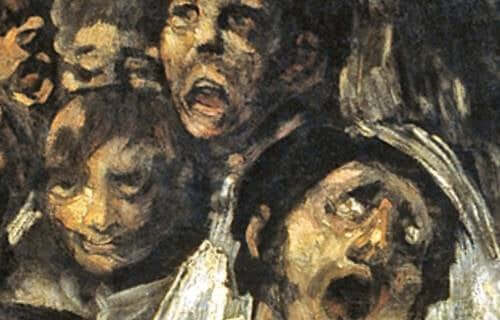The psychology of Goya’s black paintings remains an enigma, this set of mysterious and truculent paintings that decorated the Quinta del Sordo was created through a unique cosmogony, the product of a tired mind, sometimes desperate and determined by a historical context marked by repression.
But was the torment suffered by Francisco de Goya the result of a psychological disorder?. We cannot ignore how each artist’s creative universe works: the misfortunes of life are reflected in all canvases and even in the choice of colors.
- The fourteen works that make up the so-called black paintings were a significant change in his career.
- He went from light to shadow; he was the master of color and ended up living in a house where darkness stained his walls.
- He was the most prominent retratist in Spanish society and ended up decorating his house with distorted.
- Burlesque and demonic faces.
These characters could serve to expose their feelings, thoughts and all the horrors experienced in the past, so, almost unknowingly, Goya would anticipate contemporary painting, this intentional distortion, and the tone in which the darkness of a tormented soul vibrated gave way to Expressionism. .
Mercury red, aturipigment, lead white, black vine wood charcoal, Prussian blue and various types of ochre are the pigments that Francisco de Goya himself produced and that served to create these works of Quinta del Sordo, thanks to several historical documents and testimonies of the time, we know how much the paintings were exhibited.
Upstairs were Two Strangers, O Santo Ofocio, Asmodea, Um Dog and Two Witches, Atropos, Two Men and Two Women; the darkest and most striking were, curiously, made in the dining room, located on the ground floor and used for social events. . There was Saturn, La Romera de San Isidro, El gran cabron, La Leocadia, Dos viejos, Judith and Holopherne.
He didn’t care much that the few visits he received were shocked by these images, not that it could be reported. We cannot forget that Goya has always been an uncomfortable figure for the Inquisition, for any ecclesiastical institution that has seen in him an artist who has not hesitated to portray the perversions of those who abused power.
One of the goals of the psychology of Goya’s black paintings is to know what led him to paint them, not only do we question his mental state, whether he suffered from any disorder or not, one of the doubts is whether he painted them. out of sheer emotional need, out of sheer pleasure, or if she wanted to leave something to posterity (and in particular her grandson, whom she left Quinta del Sordo).
Let’s look at some aspects of his work to understand his inner world
To understand Goya das Pinturas Negras, it is interesting to speak first of Caprichos, these 80 engravings already give us a clue about the change in the life of the Aragonese artist, at that time his autoimmune disease was already present.
Susac syndrome manifested itself at age 46, weakening his physical and psychological health. Were the headaches as well as dizziness and visual disturbances constant?All this has created a new pigment in the art of the Aragonese master: that of darkness and anguish.
One of the neurological consequences of this rare disease was undoubtedly deafness, have their sensory faculties been distorted, their glare, their light, their sound, their hope?Was it the first approach to the unconscious, to your inner world, to capture the grotesque, the monstrous, the fantastic like no one else?
In these engravings, did Goya bring us a reflection of the superstitions of the simple people of the time, of those who believed in demons, witches and ghosts?Night creatures that have invaded dreams and nightmares.
In much of Francisco de Goya’s work (1746–1828) restless characters coexist, was it a reflection of a mental disorder?In no way, was it the exceptional creation of an artist that reflected the irrationality of a degraded society in which he himself lived like no other?And that left him desperate.
Few artistic figures have transmitted so well inner torment, loneliness, fear and despair. When Goya arrived at your country house, La Quinta del Sordo, in your mind it still bubbled the memory, the sound of executions, the pain of exile, the burning of Disloyalty?The psychology of Goya’s black paintings tells us that what hurt was life.
As Dr. Ronna Hertzano of the University of Maryland explains, Susac syndrome causes inflammation of the brain, something like this generates hallucinations and little blood in the eyes and ears, hence deafness, vision problems, suffering?
In Black Paintings there is no light because there was no hope for Francisco de Goya, a desperate man who suffered in an equally chaotic world.
Your? Saturn? He devours his son and?Judith and Holoferne were these mythological figures that Freud would later use for his theories. The symbolic account of these latter works represents nothing but the most sinister and atvic human being; our darkest side.
Goya only connected with him to shape it, it was the channel that brought us the darkness of our nature, those shadows that we don’t always like to see.

